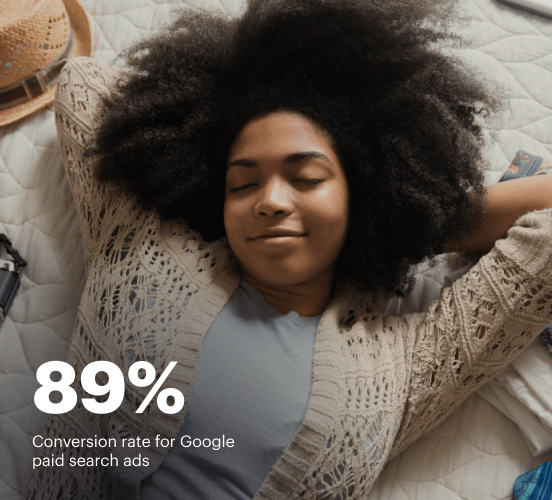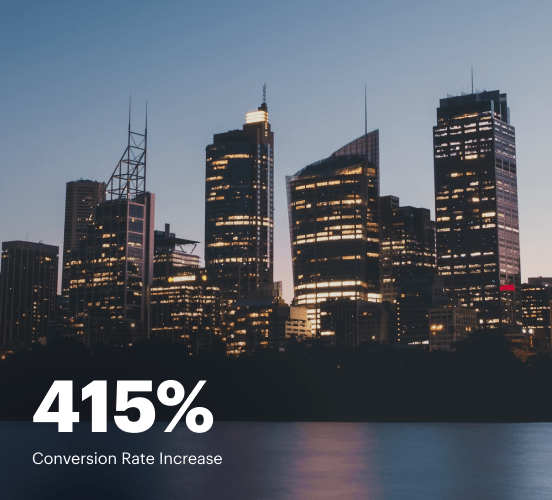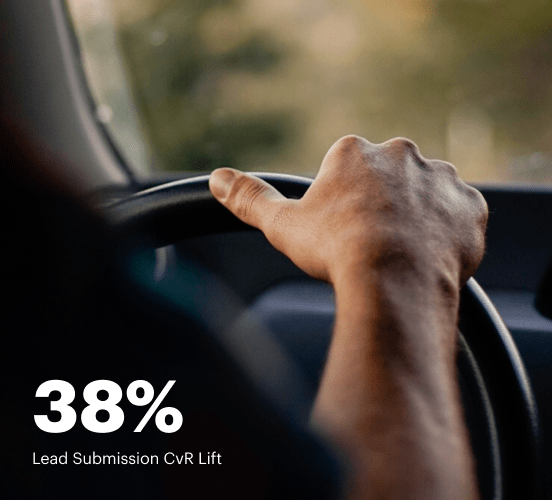How WordPress vs. Webflow vs. Instapage stack up against each other
Compare Instapage with WordPress and Webflow to create high-converting landing pages. With personalization, optimization, and collaboration tools, Instapage helps you deliver experiences that drive results.
Get startedSee how Instapage stacks up against the competition
| Feature | Instapage | Other builders |
| Drag-and-Drop Tools | ||
| Conversion-optimized templates | ||
| Manual and AI-powered A/B Tests | ||
| AI content suggestions | ||
| Popups and sticky bars | ||
| Canvas and grid blocks | ||
| Reusable and global elements | ||
| Form and popup builders | ||
| Built-in Heatmaps | ||
| Central analytics dashboard | ||
| Ad-to-page personalization and collections | ||
| Contacts, lists, and email | ||
| Dedicated, full-service CRO experts | ||
| Enterprise-ready platform |
Leading the way in building high-performing landing pages





Why Instapage is the smarter choice for your campaigns
Get everything you need to build, scale, and optimize high-converting landing pages—without coding.

Easier page building without coding
Instapage offers a flexible and seamless page creation experience with a library of 500+ conversion-focused layouts, Instablocks®, a drag-and-drop builder, and AI content generation. With technologies like Thor Render Engine®, you can create on-brand, mobile-responsive landing pages that load quickly and start converting during initial visitor clicks.

More insights — better results
Instapage lets you see in detail how each landing page experience and variation is performing so you can make targeted changes that boost page conversions. Use heatmaps for a better understanding of on-page activities, run A/B tests and AI-assisted experiments, and then track and evaluate results within robust analytics dashboards.

More personalized experiences
Instapage lets you quickly create high-performing landing pages tailored to each of your ad campaigns. Deliver personalized experiences for distinct audiences using dynamic text replacement. Effortlessly align specific advertisements to unique pages with AdMaps. Monitor audience-level metrics using our advanced data tools.

Built-in collaboration
Instapage collaboration capabilities bring your entire team together to speed up the process of landing page review, approval, and launch. No more frustrating and unnecessary revisions or edits scattered across emails. Provide instant feedback, conduct real-time page edits, and securely share your pages with outside stakeholders.

Free up time for your business
Invest time into business growth, not busy work. Launch landing pages faster with reusable forms and templates. Build once, reuse forever.
Explore all integrations






Easier page building without coding
Instapage offers a flexible and seamless page creation experience with a library of 500+ conversion-focused layouts, Instablocks®, a drag-and-drop builder, and AI content generation. With technologies like Thor Render Engine®, you can create on-brand, mobile-responsive landing pages that load quickly and start converting during initial visitor clicks.
More insights — better results
Instapage lets you see in detail how each landing page experience and variation is performing so you can make targeted changes that boost page conversions. Use heatmaps for a better understanding of on-page activities, run A/B tests and AI-assisted experiments, and then track and evaluate results within robust analytics dashboards.
More personalized experiences
Instapage lets you quickly create high-performing landing pages tailored to each of your ad campaigns. Deliver personalized experiences for distinct audiences using dynamic text replacement. Effortlessly align specific advertisements to unique pages with AdMaps. Monitor audience-level metrics using our advanced data tools.
Built-in collaboration
Instapage collaboration capabilities bring your entire team together to speed up the process of landing page review, approval, and launch. No more frustrating and unnecessary revisions or edits scattered across emails. Provide instant feedback, conduct real-time page edits, and securely share your pages with outside stakeholders.
Free up time for your business
Invest time into business growth, not busy work. Launch landing pages faster with reusable forms and templates. Build once, reuse forever.
Explore all integrationsGet started with Instapage in a few steps
-
Create your Instapage account
Start with Instapage by signing up via Google or your email. You'll get access to a free 14-day trial to discover Instapage capabilities. Feel free to cancel anytime during the 14-day trial if you decide that our product is not suitable for your business. -
Build and personalize your page
Create your first landing page from scratch or choose a template from 500+ customizable layouts. Use the drag-and-drop builder to add page elements, fonts, and backgrounds, refine content with AI, or add custom HTML, Javascript, and CSS. -
Review and make edits
Collaborate on page designs and streamline review processes. Invite your team members and stakeholders to review, edit, and provide feedback on your landing page. Collaborate knowing your page is confidential and only accessible to authorized users. -
Publish and track page performance
Publish your page to a domain or custom URL. Connect your pages to the ads you've created and track page performance within the analytics dashboard, run A/B tests and AI experiments, analyze results, and continuously optimize your landing page to maintain high conversions.
Instapage vs. WordPress vs. Webflow – The Battle of the Landing Page Builders
Choosing the right landing page builder is like selecting the ideal companion for a long voyage. Each option has its unique strengths and capabilities, ultimately aiming to get you to your destination quicker and more efficiently. Today, we’re exploring three formidable contenders in the digital space: Instapage, WordPress, and Webflow. Each brings its unique flavor to the table, making the choice that much more enticing yet challenging. In this showdown, we will unpack their features, strengths, and weaknesses. You will come away with clarity on which option can best help marketers reduce costs, grow conversions, and optimize landing page experiences. So, grab your digital toolkit and let’s dive in! (This article promises to enrich your understanding with a colorful array of insights and friendly comparisons as we explore these tools.)
Meet the Heavyweights: An Overview
In one corner, we have Instapage, a robust platform known for empowering marketers to deliver tailored landing page experiences that can significantly boost brand trust and customer loyalty. Next up is WordPress, the king of content management systems with a vast library of themes and plugins. And in the third corner, we have Webflow, a modern design tool that offers unrivaled flexibility for web designers and developers. Each of these platforms has carved out a niche for itself in the competitive world of digital marketing, boasting unique features tailored to different needs. Instapage shines with its focus on conversion optimization, WordPress offers expansive functionalities, and Webflow captivates with its visual design capabilities. Understanding these differences will help marketers decide which platform aligns best with their goals and objectives. (Throughout this overview, we’ll highlight how these tools can shape a marketer’s journey towards success.)
Round One – Feature Showdown: Who Offers More?
Template Variety and User Friendliness: A Comparison
When comparing template variety and ease of use, Instapage stands out with its extensive library of high-converting templates that cater to various industries. It supports a drag-and-drop functionality that allows even the most novice users to craft professional-looking landing pages without a steep learning curve. WordPress, while powerful, can sometimes feel overwhelming with its myriad themes, especially if users are not familiar with the setup. In contrast, Webflow combines high-end design features with usability, making it an excellent choice for those who have a bit of web development experience. However, it may have a steeper initial learning curve compared to Instapage. (Comparing these platforms, it’s essential to consider how quickly one can get a landing page up and running while maintaining design integrity and user engagement. Each option brings unique strengths that cater to different audience nuances.)
Instapage: Your Ultimate Ally in Customization and Growth
Instapage doesn't just provide templates but offers unparalleled customization options and conversion optimization tools that set it apart. Users can personalize their landing pages extensively, tailoring every element to resonate with their target audience. Beyond simple aesthetics, the platform is packed with features designed to improve conversion rates, like A/B testing and analytics that provide insight into performance. Instapage empowers marketers to reduce costs and drive meaningful engagement through efficient landing page strategies that inspire trust. Thus, marketers can grow their conversions, foster customer loyalty, and enhance the overall user experience, all while reinforcing their brand's credibility in the digital landscape. (When we discuss the actual tools and metrics for success, Instapage shines brightly in this realm.)
Round Two – Speed and Performance: The Need for Speed
Website speed can make or break a user’s experience, akin to the frustration of waiting at a coffee shop for an overly complicated order. In the fast-paced online environment, speed matters immensely. A landing page that loads slowly can result in high bounce rates, losing potential customers before they even see your value proposition. All three platforms strive to ensure optimal performance, but differences exist.
Advantages of Instapage in Speed and Performance
- Instapage offers optimally coded templates ensuring faster load times.
- Utilizes built-in AMP support for lightning-fast mobile landing pages.
- Dedicated cloud infrastructure guarantees high performance during traffic surges.
- Analytics tools help identify performance bottlenecks quickly.
WordPress Advantages in Speed and Performance
- Flexibility to choose speed-optimized hosting solutions.
- Extensive caching plugins available to boost load times.
- Lightweight themes can be selected for faster performance.
Webflow Advantages in Speed and Performance
- Built-in responsive design optimizations for faster experience across devices.
- Lightweight code generation for swift load times.
- Automatic scaling on hosting for peak performance.
In the final tally of speed and performance, all three platforms showcase unique strengths that can be advantageous depending on the user’s needs. However, Instapage stands out due to its focus on delivering high-performing landing pages, ensuring users experience minimal loading times, which is vital for gaining conversions and retaining users. It becomes increasingly clear that, while all three have promising attributes, Instapage might just have the edge in the speed department.
Round Three – Knowing the Experience: Usability and Learning Curve
Navigating any platform can be daunting, much like entering a new city without a map. Instapage prides itself on a user-friendly interface with a straightforward design that welcomes both rookies and veterans. The drag-and-drop functionality is intuitive, allowing for quick edits and modifications. WordPress, while powerful, can be akin to a vast cityscape; it requires some time to learn the ropes of its functionality and plugins. For those familiar with coding, Webflow provides invaluable freedom to customize with its design-first approach, but it may take longer for newbies to acclimate to its system. Each platform offers robust support for users at different skill levels, ensuring that anyone can grow into their role quickly. (The key takeaway here is that regardless of your starting point, each tool is equipped to support your journey in becoming proficient in landing page creation.)
Round Four – The Support Team: Who Has Your Back?
Imagine having a trusty sidekick ready to assist at every turn – that's the kind of support you can expect from these platforms. Instapage offers live chat, email support, and an extensive knowledge base, ensuring users have access to immediate help while also empowering them to solve issues independently. WordPress enthusiasts benefit from a massive community forum where experienced users readily share insights. Similarly, Webflow brings forward a dedicated support team along with educational resources, enabling users to tap into a wealth of knowledge. Each platform recognizes that responsive customer support is crucial in enhancing the user experience and ensuring smooth navigation. (In this round, the importance of comprehensive support cannot be understated, as it can significantly influence the overall user engagement and satisfaction.)
Round Five – The Final Cost Conundrum: Finding the Best Value
As users evaluate the features of each platform, price remains a crucial factor. Instapage, while premium-priced, offers significant value with the extensive customization and optimization capabilities it provides. In contrast, WordPress can be more budget-friendly but may require additional costs with premium themes and plugins. Webflow typically follows a tiered pricing structure that balances features against budget requirements, making it a smart choice for those focused on design. Ultimately, the investment in any of these tools hinges on the marketing goals you wish to achieve and which platform aligns best with those objectives.
In conclusion, while each platform brings its own strengths to the table, the best choice truly aligns with the unique needs of the user. Instapage emerges as a powerful option for those focused on customization and conversion optimization, providing essential tools to enhance marketing efforts. Consider what features and pricing matter most to your strategy and take Instapage for a spin with their free trial - it might just be the partner you're searching for to drive authentic growth.










